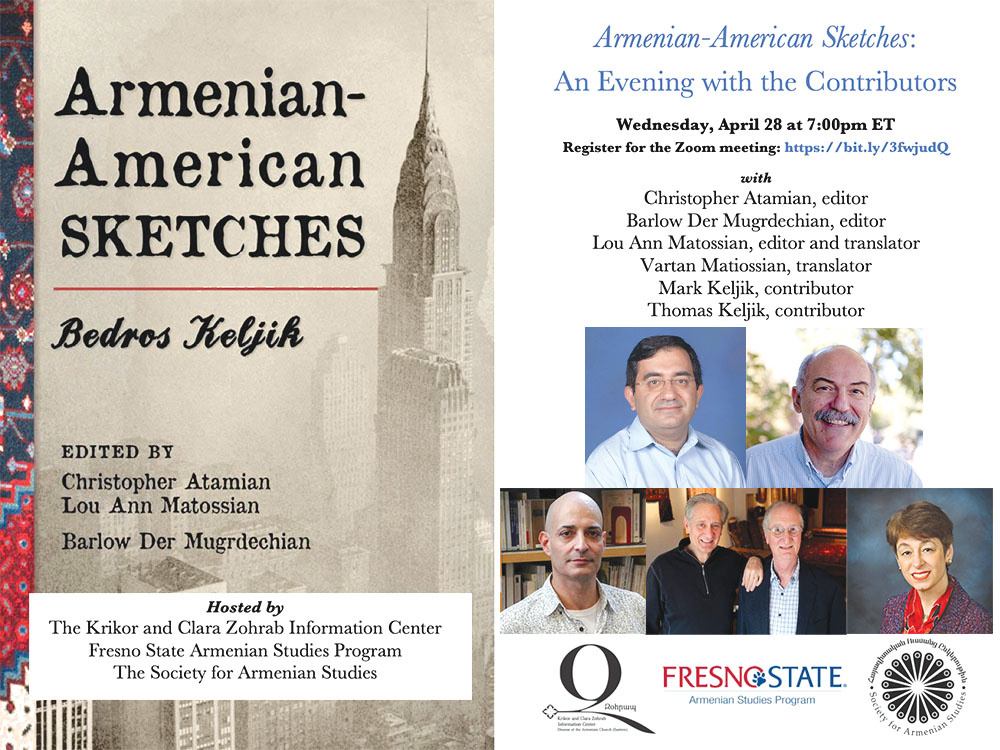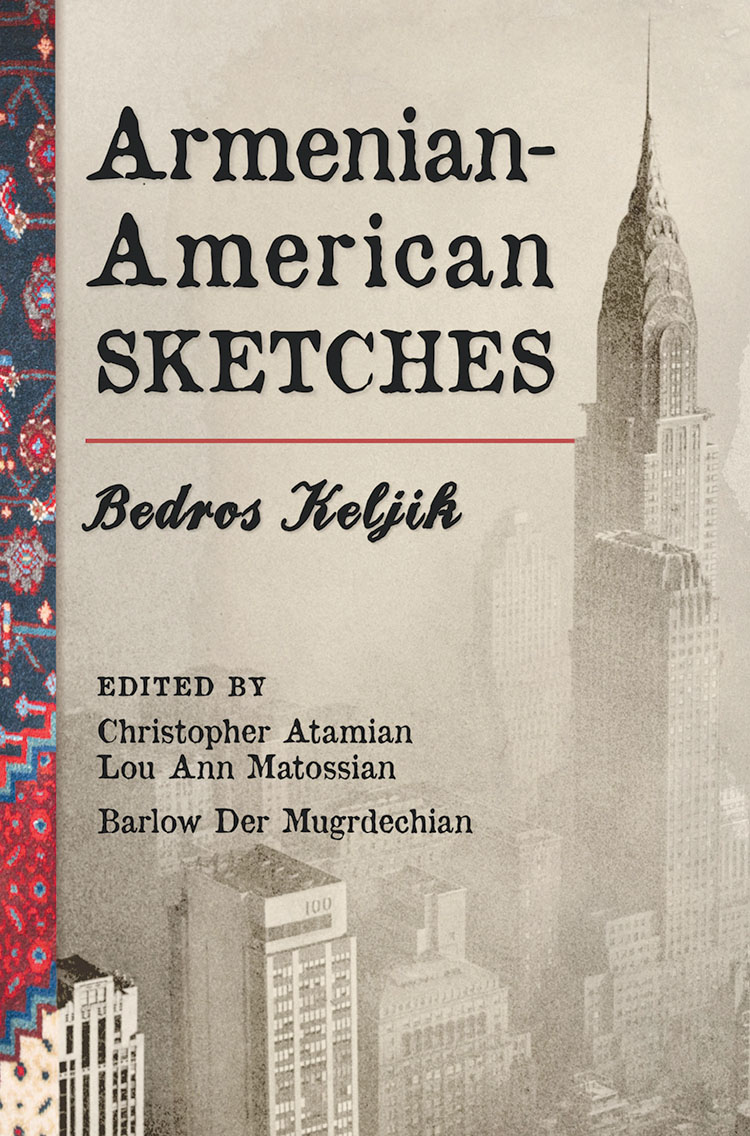
Christine Pambukyan
Staff Writer
“Bedros Keljik’s Armenian American Sketches brings to life one of the early chapters of the storied history of the Armenian-American community, whose presence on this continent long precedes the events of 1915 and even the Hamidian massacres of the nineteenth century,” said Jessie Arlen, interim director of the Krikor and Clara Zohrab Information Center.
On April 28, 2021 the Krikor and Clara Zohrab Information Center hosted a virtual panel discussion “Armenian-American Sketches: An Evening With the Contributors,” co-hosted by the Society for Armenian Studies and the Armenian Studies Program at Fresno State. The panelists discussed Bedros Keljik’s life, the process of how English translations of Keljik’s stories were completed, and finally comments on the stories themselves.
Awarded the Dr. Sona Aroian Award for Best Armenian Studies Book in 2020 by the National Association for Armenian Studies (NAASR), Armenian-American Sketches is composed of short stories that give insight on the early history of Armenian immigrant communities in America.
Professor Barlow Der Mugrdechian, Berberian Coordinator of the Armenian Studies Program, opened the discussion by emphasizing the importance of Bedros Keljik’s works and how it captures the story of immigration and the life of Armenian-Americans in the nineteenth and twentieth centuries.
After reading an excerpt from one of Keljik’s stories, Prof. Der Mugrdechian recommended that viewers read Armenian-American Sketches to gain an understanding of the American diasporan experience. “Most of the stories have a lot of humor, so they are able to capture a picture of that period but in an engaging way,” said Prof. Der Mugrdechian, the general editor of the Armenian Series of the Press at Fresno State. “It is a great book for anyone to pick up and to read as it illustrates the challenges and triumphs of Armenian-Americans in the early 20th century.”
Co-editor Christopher Atamian explained how some of the stories describe life in a part of Massachusetts that has been gentrified and no longer exists, making Keljik’s works a historic record in a sense. “I grew up in Boston, and I remember that area that he describes, and I know that none of those buildings are still there, so it’s also a record for America of what happened in our urban centers at a certain time,” says Atamian, a multi-platform storyteller based in New York, who has translated six books from French and Western Armenian into English.
Dr. Lou Ann Matossian, a co-editor and translator of one of Keljik’s stories, gave a background of Bedros Keljik’s life. “Born in Kharpert, in historic Western Armenia, Bedros Arakel Keljik belongs to the founding generation of the Armenian-American authors, but his short stories about early Armenian immigrant life are only now emerging from obscurity,” stated Dr. Matossian. As a young immigrant in Boston, Keljik spoke out about human rights as a member of the Hnchak party and brought awareness to the Armenian Question by translating Armenian poems with Alice Stone Blackwell during the Hamidian Massacres.
 Keljik then moved to Chicago in 1896, where he sold oriental rugs and graduated from law school. In November of 1899, he moved to Saint Paul, Minnesota, becoming the first Armenian to settle permanently there as he started his family oriental rug business. Bedros and his wife, Zabel Kertikian Keljik, had two sons, Woodrow and Emerson, and one daughter, Suzanne.
Keljik then moved to Chicago in 1896, where he sold oriental rugs and graduated from law school. In November of 1899, he moved to Saint Paul, Minnesota, becoming the first Armenian to settle permanently there as he started his family oriental rug business. Bedros and his wife, Zabel Kertikian Keljik, had two sons, Woodrow and Emerson, and one daughter, Suzanne.
“Mark Keljik, his grandson, happened upon Bedros’ work in the Library of Congress… eventually leading to the first translation and publication of his work into English in 1997,” said Dr. Matossian.
Dr. Vartan Matiossian, translator of eight of the short stories originally published in Baikar, described his experience translating Keljik’s works into English. “This was both an easy and difficult task,” explained Dr. Matossian. Because Bedros Keljik followed his teacher’s style, which is simple and had Christian themes, rather than the ornate and convoluted style of Keljik’s friend, Ruben Zartarian, it was easier for Dr. Matossian to translate his works. The difficult part was making sense of the Armenian to English translation in terms of grammar, emotion, and vocabulary.
Dr. Matossian concluded by emphasizing the importance of translation and its role in keeping memories and cultures alive. “There are so many treasures hidden behind the curtain of language and there is so little to do to open that curtain and discover the treasures. One must only learn the language,” explained Dr. Matossian.
Prof. Der Mugrdechian read a short story from the book, “Our Garden and My Grandmother.” The story reflects the nostalgia the early generation of Armenian immigrants felt when they immigrated to America.
Two of Bedros Keljik’s grandchildren, Tom and Mark Keljik, participated in the discussion. Tom began with a story his grandfather used to tell his father and uncle.
“My grandfather Sahag gave me a nickel to spend in the market. I had the nickel in my fist very tightly and went to survey the various offerings… I decided on the pistachios. When I opened my hand to pay, the nickel had vanished. Do you know what that means? Don’t hold on to anything too tightly,” remembered Tom, a former high school teacher and retired writer for the Minneapolis Star newspaper.
Then, Tom explained how the story reflected Bedros Keljik’s personality. “He had to, like a comedian, change from time to time, based upon the circumstances of life; but he continued to seize the opportunity, to seize the day, and to make something of it,” explained Tom.
“As for his character, [my grandfather] was non-perturbable… If he was interested in something, he concentrated on it. He didn’t let the circumstances and the hubbub influence him,” added Mark Keljik, who inherited the family carpet business in Minnesota.
The event is archived on the Armenian Studies Program YouTube channel.
Armenian-American Sketches, number eleven in the Armenian Series, can be purchased online from Abril bookstore at http://www.abrilbooks.com/armenian-american-sketches.html, the NAASR bookstore at https://naasr.org/products/armenian-american-sketches, or the Eastern Prelacy Bookstore at https://armenianprelacy.org/shop/armenian-american-sketches-english-translation/.
 Hye Sharzhoom Armenian Action
Hye Sharzhoom Armenian Action